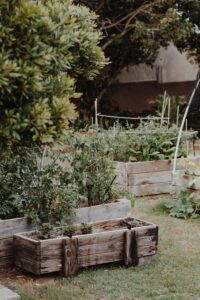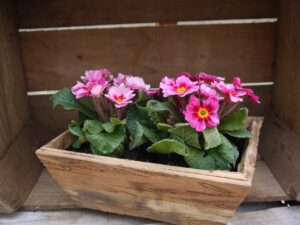If you’ve always wanted to add a touch of greenery to your home but don’t know where to start, we’ve got just the thing for you. Our article dives into the world of DIY planter box projects specifically designed for beginners. Whether you have a small balcony or a spacious backyard, these projects are simple, fun, and perfect for anyone looking to unleash their creativity. We’ve covered you, from upcycling old wooden crates to building your planter box from scratch. So grab your tools and prepare to bring some life to your living space!
Types of Planter Boxes
Raised Bed Planter Box
A raised bed planter box is an excellent option for those who want to grow plants and vegetables on a larger scale. These planter boxes are typically rectangular and elevated off the ground, making them ideal for growing plants with deep root systems. They can be made from various materials, such as wood, plastic, or metal.
Window Box Planter
Window box planters are perfect for adding a touch of beauty and greenery to the exterior of your home. These long, narrow boxes are designed to be mounted underneath windows and can be filled with various flowers, herbs, or trailing vines. Window box planters are usually made from wood or plastic and come in multiple sizes and styles to suit different window types.
Hanging Planter Box
Hanging planter boxes are popular for those with limited space or for adding a decorative touch to porches, balconies, or patios. These boxes are typically made from lightweight materials such as plastic or metal and designed to hang from hooks or brackets. They can be filled with a range of plants, from vibrant flowers to cascading vines, to create a beautiful vertical display.
Vertical Planter Box
Vertical planter boxes are a unique and space-saving option for those who want to maximize their greenery. These innovative planters are designed to be mounted on walls or fences, allowing you to create a vertical garden. Vertical planter boxes can be made from various materials, including wood, plastic, or metal, and customized to fit your desired style and space.
Choosing the Right Materials
Wooden Planter Boxes
Wooden planter boxes are a classic and versatile choice for DIY enthusiasts. They provide a natural and rustic look that complements various styles of gardens and outdoor spaces. Cedar and redwood are popular for wooden planter boxes as they naturally resist rot and insect damage. However, any weather-resistant wood can be used for this project.
Plastic Planter Boxes
Plastic planter boxes are lightweight, durable, and easy to maintain. They come in various colors and styles, allowing you to find the perfect match for your garden or home decor. Plastic planter boxes are also affordable and resistant to rot and decay, making them a practical and long-lasting option.
Metal Planter Boxes
Metal planter boxes can add a touch of modern elegance to any space. They are sturdy, durable, and resistant to weather conditions. Aluminum and galvanized steel are famous for metal planter boxes as they are lightweight and corrosion-resistant. However, remember that metal planter boxes can heat up quickly in direct sunlight, so consider the heat tolerance of your plants when using them.
Concrete Planter Boxes
Concrete planter boxes provide a sleek and contemporary look that suits indoor and outdoor spaces. They are incredibly durable and resistant to harsh weather conditions. Concrete planter boxes can be made using molds or creating a custom form. Since concrete is porous, it is recommended to line the interior of the planter with plastic or a waterproofing agent to prevent water damage.
Tools and Materials Needed
To build your planter box, you will need the following tools and materials:
Measuring Tape
A measuring tape is essential for accurately measuring the dimensions of your planter box and ensuring precise cuts.
Saw or Circular Saw
A saw or circular saw will be needed to cut the wooden or plastic materials to the desired dimensions.
Drill
A drill is necessary for creating holes for screws and drainage, as well as for attaching any additional components or decorative elements.
Screws
Screws are used to join the pieces of the planter box together securely. Make sure to choose screws that are appropriate for the material you are working with.
Sandpaper
Sandpaper is essential for smoothing rough edges and surfaces of the planter box, ensuring a professional finish.
Staple Gun
A staple gun helps attach any lining material, such as plastic or landscape fabric, to the interior of the planter box.
Paint or Stain
If desired, you can paint or stain your planter box to add a pop of color or enhance the natural beauty of the wood or other materials.
Paintbrush
If you choose to paint or stain your planter box, a paintbrush will be needed.
Potting Soil
Potting soil is necessary to create a suitable growing medium for your plants. Choose a high-quality potting mix appropriate for the type of plants you will be growing.
Plants or Seeds
Select the plants or seeds you wish to grow in your planter box. Consider each plant’s specific needs, such as sunlight and space.
Building a Basic Planter Box
Measuring and Cutting the Wood
Start by measuring and marking the desired dimensions for your planter box on the wood. Use a saw or circular saw to cut the pieces according to your measurements. You will need a bottom piece and four sides to assemble the basic structure.
Assembling the Box
Once you have cut the wood pieces, begin assembling the planter box. Start by attaching one side piece to the bottom piece using screws. Repeat this process with the remaining three sides, ensuring all corners are square and the box sturdy.
Sanding and Finishing Options
After assembling the basic box structure, use sandpaper to smooth rough edges or surfaces. This step will help prevent splintering and create a polished look. Depending on your preference, you can paint, stain, or leave the planter box unfinished to showcase the natural beauty of the wood.
Adding Drainage Holes
Determining the Size and Placement of Drainage Holes
Proper drainage is crucial for your plants’ health and the planter box’s longevity. Determine the size and placement of drainage holes based on the size of your planter box, the type of plants you will be growing, and the material used for the box.
Drilling the Holes
Using a drill, carefully create drainage holes at the determined locations. Drill through the bottom of the planter box to allow excess water to drain out effectively.
Customizing Your Planter Box
Painting or Staining the Box
To personalize your planter box, consider painting or staining it in a color that complements your home’s exterior or your garden’s theme. Use outdoor paint or stain designed to withstand exposure to the elements.
Adding Decorative Elements
Enhance the aesthetic appeal of your planter box by adding decorative elements such as trim, molding, or carved designs. These embellishments can be attached using a drill and screws or a strong adhesive.
Personalizing with Names or Quotes
Personalize your planter box with names, quotes, or meaningful messages to make it truly unique. You can use stencils, decals, or hand-paint the desired text directly onto the planter box.
Fitting Trellis or Lattice
If you plan to grow climbing plants or vines, consider attaching a trellis or lattice to the back or sides of the planter box. This will support the plants as they grow vertically, creating a stunning display.
Creative Planter Box Ideas
Tiered Planter Box
A tiered planter box offers a visually appealing way to grow multiple plants in a compact space. By stacking the planter boxes vertically, you can create a cascading effect and showcase a variety of plants at different heights.
Herb Garden Planter Box
Design a planter box specifically for growing an assortment of herbs. Divide the planter box into sections, each designated for a different herb. This way, you’ll conveniently have all your favorite herbs in one place.
Fairy Garden Planter Box
Create a magical and whimsical miniature fairy garden within a planter box. Use small plants, miniature accessories, and tiny figurines to bring this enchanting world to life. Add fairy lights for an extra touch of magic.
Succulent Planter Box
Succulents are low-maintenance and drought-tolerant plants that thrive in well-drained soil. Design a planter box specifically for succulents, incorporating different types and sizes of succulent plants for a stunning and easy-to-care-for arrangement.
Maintaining Your Planter Box
Watering and Fertilizing
Consistently watering and fertilizing your plants is essential for their growth and overall health. Check the soil’s moisture level regularly and water the plants as needed. Apply an appropriate fertilizer according to the plant’s specific needs.
Pruning and Trimming
Regularly prune and trim your plants to maintain their shape and promote healthy growth. Remove any dead or diseased parts to prevent the spread of pests or diseases.
Protecting Against Pests
Monitor your planter box for any signs of pests, such as aphids or snails. Use organic pest control methods or insecticidal soaps to deter and eliminate pests without harming your plants or the environment.
Troubleshooting Common Issues
Overwatering
Overwatering can lead to root rot and other problems. Ensure that your planter box has proper drainage, and only water your plants when the top inch of soil feels dry to the touch. Adjust your watering schedule based on the plants’ specific needs.
Underwatering
Underwatering can cause plants to wilt and become stressed. Water your plants regularly, especially during hot and dry periods. Monitor the soil’s moisture level and adjust your watering schedule as necessary.
Root Rot
Root rot can occur if the soil remains consistently waterlogged, leading to the decay of the plant roots. Avoid overwatering and ensure proper drainage in your planter box. If root rot is already present, remove the affected plants and replace the soil.
Pest Infestation
Pests such as aphids, snails, or fungal gnats can infest your planter box and damage your plants. Monitor your plants regularly, use organic pest control methods, and remove any infested plants to prevent further spread.
Recycling and Upcycling Ideas
Using Old Pallets or Crates
Transform old pallets or crates into unique and rustic planter boxes. By disassembling and reassembling the pieces, you can create a one-of-a-kind planter box with a distinct character.
Repurposing Old Furniture
Repurpose old furniture into a planter box to give it a new lease on life. Old dressers, cabinets, or even chairs can be transformed into attractive and functional planters with creativity and basic carpentry skills.
Creating Planter Boxes from Tin Cans
Upcycle empty tin cans by transforming them into mini planter boxes. Clean the cans thoroughly, paint them your desired color, and add drainage holes at the bottom. These charming tin can planters can be hung or placed on a windowsill.
Upcycling Broken Clay Pots
Instead of discarding broken clay pots, repurpose them into whimsical planter boxes. Break the pots into smaller pieces, layer them in a larger pot or container, and create a unique cascading effect by adding soil and plants between the broken pieces.
With these tips and ideas, you are well on your way to creating and maintaining your very own DIY planter boxes. The possibilities are endless, from the type of planter box to the choice of materials and the customization options. So grab your tools and prepare to nurture your green thumb in style!



